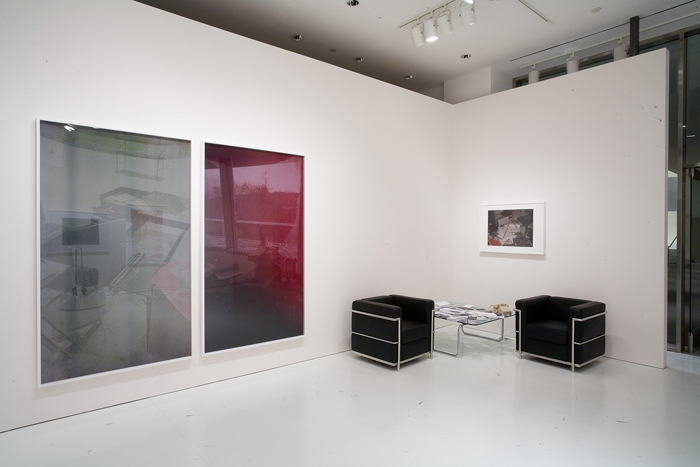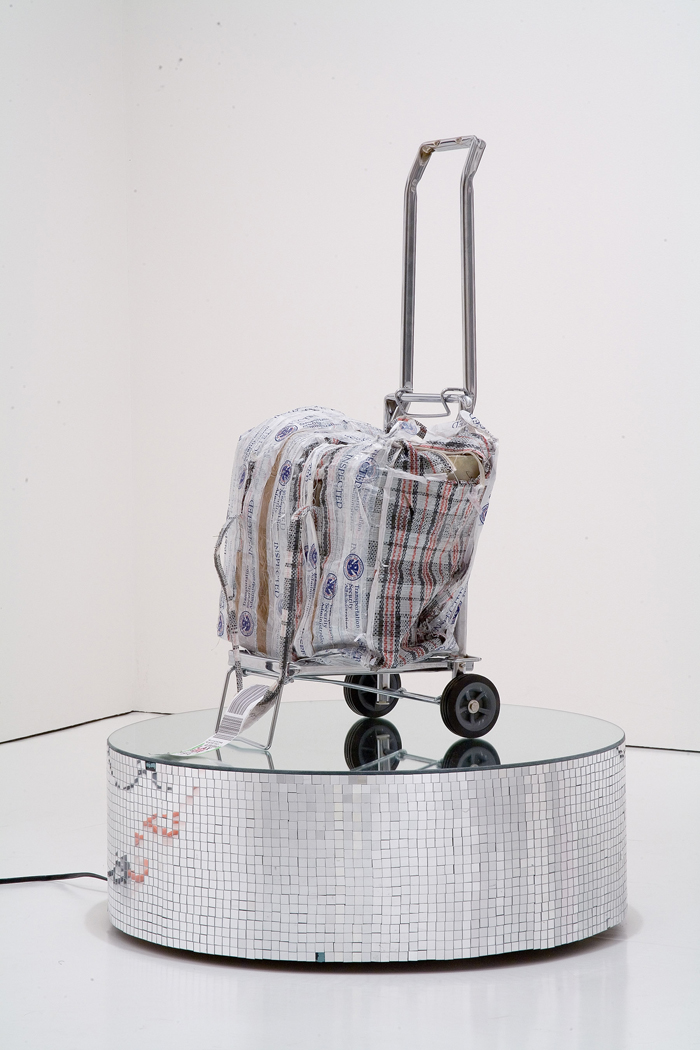
Walead Beshty, Installation at the Hammer Museum, Los Angeles, 2006. Dimensions variable. Courtesy the artist, Wallspace Gallery, New York, and China Art Objects Galleries, Los Angeles. Photo: Joshua White.
Walead Beshty admits to being drawn to relics, but of course, who isn’t? He used the term in a non-religious sense on a number of occasions in writing and when speaking about his recent exhibition at the Hammer, whose subject is the abandoned Iraqi diplomatic mission to the now-defunct DDR in East Berlin.1 Beshty first heard about the building in 2001, on the eve of a new war in Iraq, and was captivated by the site’s strange stasis: given in perpetuity to Iraq by the former East Germany, it therefore belongs to a country of indeterminate nationhood and is located within the borders of a political entity that no longer exists. The site was abandoned hurriedly about 10 years ago and therefore is seemingly trapped in time, a victim of entropy and politics, full of material that is slowly decaying, worthless and otherwise. His present project is a follow-up, or perhaps even a response, to a preliminary and more straightforward, photographic project documenting the diplomatic mission of the site that was published in 2004.2 While the ruin of the relic provided the initial attraction, issues, including the limitations of photography, politics, and process (artistic and otherwise) preoccupied Beshty and led him to literally revisit the site.
Beshty reaches beyond the romance of ruins and their easy appeal to our senses of nostalgia, romance, and horror. Instead he strives to activate political history and realities through aesthetic and personal means. In my mind, he was successful as he turned over his own process of discovery to the visitor who had to engage the subject at hand experientially. The exhibition brimmed with meaning, but not necessarily stable meanings; some arose from the subject itself but further meaning was generated by Beshty who himself displayed purposeful curatorial savvy in presenting the viewer with political and aesthetic problems that do not arrive with answers. Nothing, however, suggested that the meaning of the installation must remain fluid or irresolvable, as is so often assumed to be the case by critics confronted with art that bears directly on a socio-political topic—no such fashionable, easy conclusions are allowed here.
Installed in the Lobby Gallery of the Hammer Museum, Beshty’s project consisted of nine framed photographic images; a waiting area in one corner (Dismal Science Reading Room, 2006) replete with faux-Le Corbusier petite club chairs, reading material, and phone; and a more sculptural display composed of a manhandled bag attached to a luggage cart atop a rotating mirrored pedestal. References to personal journey and to the physical state of the associated material were manifest in the beleagured, cut-open bag that bore an airline luggage tag labelling the various airports Beshty had to travel through en route home. Also unwittingly and liberally “decorated” with “Inspected” tape placed by the Transportation Security Administration of the Department of Homeland Security, the bag was a now-commonplace reminder of the political and physical reality in which we live.
During his travel, Beshty’s film was accidentally damaged by an x-ray security screening, but he reconsidered his initial impulse to discard the “ruined” film when he realized that it was an “index” of his “particularly excruciating” travel. Letting happenstance be one of his guides, Beshty used the damaged film to help “reactivate” the site for the present exhibition; Beshty furthermore chose to let the film be exposed to x-ray again on the trip home.3 The damage, what Beshty later called “a gift in disguise,” was registered in most of the displayed photographs: the haziness, odd coloration, and outright abstraction operate somewhat as veils but perhaps more importantly as aesthetic signifiers, emphasizing the photographs as objects, with their own unusual formal properties, and inviting viewers to read them as such—and not simply as documents.4

Walead Beshty, Installation at the Hammer Museum, Los Angeles, 2006. Dimensions variable. Courtesy the artist, Wallspace Gallery, New York, and China Art Objects Galleries, Los Angeles. Photo: Joshua White.
Two relatively small photographs on the south wall were the most abstract of the exhibition, Political Abstract #1 and Political Abstract #3 (both, 2006), one with drippy, rich, flesh-colored streaks and the other of a dark palette with similar “damage” marks. On the west and north walls were six large, vertical, interior views of the embassy; heaped books, disheveled office furniture, and peeling paint remain legible through the x-ray distortion. The predominant pinks and greens of the color distortion render the images aesthetic objects, just as they remain portals to a real place. Centered within Travel Picture, Meadow (2006) is an empty chair stacked on top of other furniture, its elevated and unlikely position giving it a forlorn air. Travel Picture, Sunset (2006) uniquely contains a view of the outside from within the embassy: a dark foreground gives out to a surprisingly uncluttered table on which a typewriter rests; behind this, thin scrubby trees are seen through a broken window. The viewer naturally wants more context for the building, a glimpse of “alive” Berlin perhaps, but instead, it feels as if one could be anywhere. One small image over the chairs seemed to be part of the earlier series as the description of materials reads “photo documentation” and is titled matter-of-factly: Scene #1 Botschaft der Bundesrepublik Irak in Berlin, Deutsche Demokratische Republik (DDR) [Embassy of the Republic of Iraq in Berlin, German Democratic Republic (GDR)], (2001-06). The solitary black-and-white image was on a wall separating the gallery from the rest of the lobby and might easily have been missed. Suitably, it also is the only photograph of the exterior of the embassy. Facade, from Four to Six Twice, Dawn and Dusk (2006) is a composite image of two photographs, one presenting the transition from night to day and another of day to night. The mingling of imagery is not readily apparent except for a slight uncanny quality. Beshty’s harnessing of happenstance and care with such aspects as titles and positioning is striking. With only a small group of images chosen from a large body of work, Beshty allowed for both more unpacking and greater opacity.
In contradistinction to the original project—what seems in hindsight more of a documented research mission—emphasis was placed on the concept of the copy versus the original: actual objects (microfiche, papers, etc.) from the diplomatic mission in the bag on the pedestal, photocopied reading material (a mix of both things Beshty found at the embassy and things he was reading in preparation for the project), imitation furniture, and a copy of a recording from the embassy heard through the phone.5 The recording, for instance, is “original” but simultaneously cannot be “real”—or at least pertinent anymore, due to the simple passage of time. Beshty is also provocative in the display techniques he employs, confronting issues of curatorial tidiness and spectacle. His disco ball-inspired kinetic pedestal might seem “cute” but it also makes the space less solemn, a sentiment Beshty clearly wanted to avoid.
Beshty grapples with the solemnity and sadness easily bestowed on ruins, even with unremarkable ruins such as the Iraqi diplomatic mission or the abandoned shopping malls of his 2004 series Phenomenology of Dead Shopping Malls. Although he seems fascinated with architectural subjects, his interest is inspired less by the structure and more by the idea of the place. Beshty highlights the uncertainty and uniqueness of a place even if it is quite banal; and within Berlin the embassy is hardly alone in being an abandoned bureaucratic structure. Beshty’s fascination with place came full circle to the actual exhibition space, as it took place in a lobby—and thus a transitional space—below the museum proper. The artist also found a link between the Berlin- based embassy and Armand Hammer, the museum’s namesake (and the late chairman of Occidental Petroleum, whose offices are in the building above the museum), whom he saw as a “relic of the Cold War.”6
Beshty’s thoughtful installation invites one—without the pretenses of fetishization or heroization—to know a political relic, a category that seems unfamiliar but should not. His artistic, intellectual, and physical journey and process can be mirrored by that of an engaged visitor. Each subsequent visit to the Lobby Gallery revealed more and made me think more which, for me, makes for a near-perfect art experience. During my last visit to the exhibition, on its penultimate day, I realized that much of the photocopied reading material had vanished. The motivations were mysterious—it seemed that mostly the non-English language material had disappeared—but, like the artist himself, someone (or, more likely, some people) wanted a physical memento. Or else they simply recognized that literature in the form of a copy was of presumably less value to the unseen owner and thus free for the taking. Beshty’s process can potentially inspire multiple visits, a spell in the chair, petty thievery, a backward glance.
Some may bristle at the “homework assignment” aspect of the exhibition (wall text, displayed books, pamphlet interview, even museum programming), just as some may bristle at waiting in a lobby or at an airport jetway or baggage claim. In this case, image and text collude, not simply to inform, but to create meaning and to make a sort of art-enabled time warp possible within the confines of a small gallery. In a sense, the images work as an invitation and itinerary but the text may be one’s ticket. The combined experience is neither dogmatic nor depressing; surprisingly, given the quasi-political subject, the resultant mood is positive and future-thinking—a viable and less-explored objective within contemporary art. At their best, such projects as Walead Beshty’s at the Hammer, like the best of actual travel, burst with expectancy and promise as they position an individual on the cusp of moving, returning, and discovering.
Jennifer Wulffson Goodell is an editor at the Getty Research Institute in Los Angeles.
